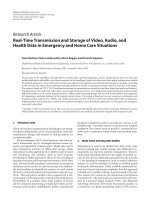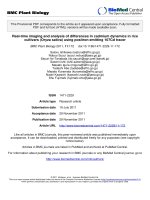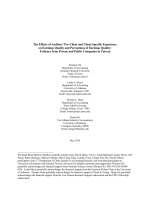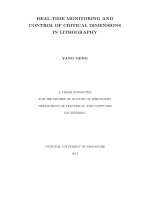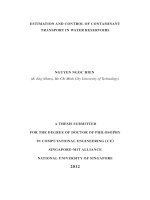Real time monitoring and control of critical dimensions in lithography
Bạn đang xem bản rút gọn của tài liệu. Xem và tải ngay bản đầy đủ của tài liệu tại đây (6.36 MB, 171 trang )
REAL-TIME MONITORING AND
CONTROL OF CRITICAL DIMENSIONS
IN LITHOGRAPHY
YANG GENG
A THESIS SUBMITTED
FOR THE DEGREE OF DOCTOR OF PHILOSOPHY
DEPARTMENT OF ELECTRICAL AND COMPUTER
ENGINEERING
NATIONAL UNIVERSITY OF SINGAPORE
2012
DECLARATION
I hereby declare that the thesis is my original work and it has been written
by me in its entirety. I have duly acknowledged all the sources of informa-
tion which have been used in the thesis.
This thesis has also not been submitted for any degree in any university
previously.
Yang Geng
24 December 2012
Acknowledgments
I am grateful to many people for supporting me not only intellectually
but also mentally and so cially in my work and life besides work. These
acknowledgements can only give a glimpse on how much I benefit and learn
from all my mentors, colleagues, friends, and family. Thanks so much to
all of you.
First of all, I wish to express my sincere gratitude to my supervisor
Assoc. Prof. Arthur Tay, who supplies me with invaluable advice and
guidance throughout my time at university concerning my research, writing,
organization, and life. His insights in the semiconductor process control
are always stimulating and many chapters of this thesis are shaped by the
numerous discussions between us.
I also would like to thank my friends and colleagues who are working
in the Advance Control Technology Lab. Their friendship, advice and
encouragement make my experience at National University of Singapore
unforgettable in my life. Special thanks are going to my parents and my
wife for their companion and love. I would have never reached so far
without their constant encouragement and support.
i
Contents
Acknowledgments i
Summary vi
List of Tables vii
List of Figures viii
List of Acronyms xiv
List of Symbols xvi
Chapter 1 Introduction 1
1.1 Motivation . . . . . . . . . . . . . . . . . . . . . . . . . . . . 1
1.2 Review of Process Control for Lithography . . . . . . . . . . 7
1.2.1 Statistical process control . . . . . . . . . . . . . . . 8
1.2.2 Run-to-run control . . . . . . . . . . . . . . . . . . . 9
1.2.3 Real-time control . . . . . . . . . . . . . . . . . . . . 10
1.3 Contribution . . . . . . . . . . . . . . . . . . . . . . . . . . . 11
1.3.1 Modelling and real-time control of multi-zone ther-
mal system . . . . . . . . . . . . . . . . . . . . . . . 11
ii
1.3.2 Ellipsometry equipment design and application . . . 12
1.3.3 Dual-zone spatial CD in-situ real-time control through
the PEB process . . . . . . . . . . . . . . . . . . . . 13
1.3.4 Feedforward/Feedback control framework for lithog-
raphy process . . . . . . . . . . . . . . . . . . . . . . 14
1.4 Organization of the Thesis . . . . . . . . . . . . . . . . . . . 15
Chapter 2 Dual-Zone Programmable Thermal Baking Sys-
tem 17
2.1 Introduction . . . . . . . . . . . . . . . . . . . . . . . . . . . 17
2.2 Thermal Modelling of the System . . . . . . . . . . . . . . . 20
2.2.1 System modelling . . . . . . . . . . . . . . . . . . . . 20
2.2.2 Model verification . . . . . . . . . . . . . . . . . . . . 26
2.3 Real-time Wafer Temperature Spatial Control . . . . . . . . 31
2.3.1 Experiment setup and control structure . . . . . . . . 31
2.3.2 Experimental result . . . . . . . . . . . . . . . . . . . 35
2.4 Conclusion . . . . . . . . . . . . . . . . . . . . . . . . . . . . 44
Chapter 3 Spectroscopic Ellipsometry Equipment Design and
Application 46
3.1 Introduction . . . . . . . . . . . . . . . . . . . . . . . . . . . 46
3.2 System Modelling . . . . . . . . . . . . . . . . . . . . . . . . 48
3.2.1 Characterization of the PEB process . . . . . . . . . 48
3.2.2 Working principle of the ellipsometry . . . . . . . . . 50
3.3 Equipment Setup . . . . . . . . . . . . . . . . . . . . . . . . 56
iii
3.3.1 Programmable thermal bake-plate . . . . . . . . . . . 57
3.3.2 Spectroscopic ellipsometer . . . . . . . . . . . . . . . 59
3.3.2.1 Single probe spectroscopic ellipsometer . . . 59
3.3.2.2 Dual-probe spectroscopic ellipsometer . . . 61
3.4 Experimental Results and Discussions . . . . . . . . . . . . . 61
3.5 Conclusion . . . . . . . . . . . . . . . . . . . . . . . . . . . . 68
Chapter 4 Dual-Zone Real-Time Monitoring and Control of
Critical Dimensions 70
4.1 Introduction . . . . . . . . . . . . . . . . . . . . . . . . . . . 70
4.2 Measurement of CD Latent Image . . . . . . . . . . . . . . . 72
4.2.1 Approach with RCWA . . . . . . . . . . . . . . . . . 73
4.2.2 Model verification . . . . . . . . . . . . . . . . . . . . 75
4.2.3 Extraction of CD latent image profile from spectro-
scopic ellipsometry measurement . . . . . . . . . . . 79
4.3 Control Framework and Experimental Results . . . . . . . . 81
4.3.1 Control framework . . . . . . . . . . . . . . . . . . . 81
4.3.2 Experimental results and discussion . . . . . . . . . . 86
4.4 Conclusion . . . . . . . . . . . . . . . . . . . . . . . . . . . . 100
Chapter 5 Feedforward/Feedback Control Framework for the
Lithography Process 101
5.1 Introduction . . . . . . . . . . . . . . . . . . . . . . . . . . . 101
5.2 Design of Control Framework . . . . . . . . . . . . . . . . . 104
5.2.1 Framework architecture . . . . . . . . . . . . . . . . 104
iv
5.2.2 Module characterization . . . . . . . . . . . . . . . . 105
5.2.3 Control algorithm . . . . . . . . . . . . . . . . . . . . 108
5.3 Experimental Results and Discussions . . . . . . . . . . . . . 110
5.4 Conclusion . . . . . . . . . . . . . . . . . . . . . . . . . . . . 115
Chapter 6 Conclusion 117
6.1 Summary . . . . . . . . . . . . . . . . . . . . . . . . . . . . 117
6.2 Future Works . . . . . . . . . . . . . . . . . . . . . . . . . . 120
Bibliography 124
Appendix 136
Author’s Publications 145
v
Summary
Lithography is a key enabler accounting for a third of IC manufacturing
costs. Critical dimension (CD) is the most important variable in the lithog-
raphy sequence affecting the speed of the circuit. Current approaches to
CD control are primarily based on a run-to-run strategy due to a lack of in-
situ sensors and control authority. In this thesis, we proposed an approach
to conduct real-time CD monitoring and control. It is well-known that
temperature has a direct effect on CD. First, a multi-zone programmable
thermal processing system is developed, which is able to control the wafer
temperature uniformity during the entire thermal cycle. Next, an in-situ
ellipsometry system is established and integrated into the thermal process
to measure the CD profile in real-time. Compared with the state of art in
current semiconductor manufacturing based on a run-to-run strategy, the
proposed real-time control system is capable to monitor and control the
CD across wafer in real-time. Experimental results demonstrate that the
real-time control system improves the across wafer CD uniformity more
than 60% versus a run-to-run approach.
vi
List of Tables
1.1 Lithography technology requirements for the next decade . . 5
2.1 Physical parameters of the thermal processing system . . . . 25
2.2 Estimated air gap thickness and wafer warpage using the
real-time control method with the proximity pin height of
210 µm . . . . . . . . . . . . . . . . . . . . . . . . . . . . . . 33
2.3 Comparison between conventional baking, steady-state ap-
proach and real-time approach . . . . . . . . . . . . . . . . . 44
3.1 Experiment design . . . . . . . . . . . . . . . . . . . . . . . 64
4.1 CD latent image profile characterizations . . . . . . . . . . . 80
4.2 Thermal coupling analysis . . . . . . . . . . . . . . . . . . . 84
4.3 Temperature variation vs Power input variation . . . . . . . 84
5.1 Thin film thicknesses with different spin speeds . . . . . . . 107
5.2 Bottom positions of signatures with respect to the different
film thicknesses . . . . . . . . . . . . . . . . . . . . . . . . . 110
5.3 Tuning performed at the spin coating step . . . . . . . . . . 115
vii
List of Figures
1.1 Transistor density and minimum feature [2] . . . . . . . . . . 2
1.2 Microlithography sequence . . . . . . . . . . . . . . . . . . . 3
1.3 Source of CD variation [5] . . . . . . . . . . . . . . . . . . . 5
2.1 Schematic diagram of the thermal processing system . . . . 21
2.2 Photo of the thermal processing system . . . . . . . . . . . . 21
2.3 Open loop step responses for the 8-inch bake-plate. The
bake-plate center and edge temperatures during the baking
process are shown in subplots (a) and (b), respectively. . . . 28
2.4 Plate and wafer temperature in simulation and experiment
with air gap thickness be 140 µm using the calculated model.
The bake-plate center temperatures, bake-plate edge tem-
peratures, wafer center temperatures, and wafer edge tem-
peratures during the baking process are shown in subplots
(a), (b), (c) and (d), respectively. . . . . . . . . . . . . . . . 30
2.5 Air gap estimation for conventional baking with 140 µm
proximity pins . . . . . . . . . . . . . . . . . . . . . . . . . . 31
viii
2.6 Block diagram of the control systems framework, where k
indicates the state, T
bp1setpoint
, T
w1
and T
w2
are the desired
plate reference temperature in center zone based on the esti-
mated air gaps, the estimated wafer temp eratures in center
and edge zones, respectively. . . . . . . . . . . . . . . . . . . 34
2.7 Temperature profile of bake-plate and wafer for conventional
baking when a flat wafer is dropped on bake-plate with prox-
imity pin height of 210 µm. The bake-plate temperatures,
wafer temperatures, and wafer temperature nonuniformity
during the baking process are shown in subplots (a), (b),
and (c), respectively. . . . . . . . . . . . . . . . . . . . . . . 36
2.8 Temperature profile of bake-plate and wafer for real-time
control method when a flat wafer is dropped on bake-plate
with proximity pin height of 210 µm. The bake-plate tem-
peratures, wafer temperatures, and wafer temperature nonuni-
formity during the baking pro cess are shown in subplots (a),
(b), and (c), respectively. . . . . . . . . . . . . . . . . . . . . 38
2.9 Power inputs to bake-plate center and edge zones for real-
time control method when a flat wafer is dropped on bake-
plate with proximity pin height of 210 µm. . . . . . . . . . . 39
2.10 Schematic of warpage setup . . . . . . . . . . . . . . . . . . 40
ix
2.11 Temperature profile of bake-plate and wafer for conventional
baking when a wafer with center-to-edge warpage of 70 µm
is dropped on bake-plate with proximity pin height of 210
µm. The bake-plate temperatures, wafer temperatures, and
wafer temperature nonuniformity during the baking process
are shown in subplots (a), (b), and (c), respectively. . . . . . 42
2.12 Temperature profile of bake-plate and wafer for real-time
control method when a wafer with center-to-edge warpage of
70 µm is dropped on bake-plate with proximity pin height of
210 µm. The bake-plate temperatures, wafer temperatures,
and wafer temperature nonuniformity during the baking pro-
cess are shown in subplots (a), (b), and (c), respectively. . . 43
2.13 Power inputs to bake-plate center and edge zones for real-
time control method when a wafer with center-to-edge warpage
of 70 µm is dropped on bake-plate with proximity pin height
of 210 µm. . . . . . . . . . . . . . . . . . . . . . . . . . . . . 44
3.1 The structure of ellipsometer . . . . . . . . . . . . . . . . . . 52
3.2 Thermal bake-plate configurations . . . . . . . . . . . . . . . 58
3.3 Single probe spectroscopic ellipsometer setup . . . . . . . . . 60
3.4 Design of the dual-probe ellipsometer . . . . . . . . . . . . . 62
3.5 Dual-probe spectroscopic ellipsometer setup . . . . . . . . . 63
3.6 Thermal effect for PEB bake at 140
◦
C . . . . . . . . . . . . 65
3.7 Thermal effect with baking temperature for PEB, measured
at 125s . . . . . . . . . . . . . . . . . . . . . . . . . . . . . . 66
x
3.8 Thermal effect with the change of baking temperature in the
middle . . . . . . . . . . . . . . . . . . . . . . . . . . . . . . 67
3.9 SEM result . . . . . . . . . . . . . . . . . . . . . . . . . . . 68
4.1 CD latent image grating structure . . . . . . . . . . . . . . . 73
4.2 Comparison between one-layer and ten-layer models for an
ideal unslanted sample . . . . . . . . . . . . . . . . . . . . . 76
4.3 Comparison between the ideal unslanted sample in one-layer
model and the sloped sample in ten-layer model . . . . . . . 76
4.4 Post-development DICD SEM verification . . . . . . . . . . 77
4.5 Simulation and experimental results for 500 nm CD latent
image profile with 420 nm thickness . . . . . . . . . . . . . . 78
4.6 Simulation and experimental results for 475 nm CD latent
image profile with 430 nm thickness . . . . . . . . . . . . . . 78
4.7 Inline measured cosine signatures through PEB . . . . . . . 81
4.8 CD latent image profile variations throughout the PEB process 82
4.9 The scheme of the real-time control approach . . . . . . . . 83
4.10 Open loop step responses for the 4-inch bake-plate. The
bake-plate center and edge temperatures during the baking
process are shown in subplots (a) and (b), respectively. . . . 89
4.11 The cosine signatures of conventional baking for PEB at 130
◦
C for 125 sec at the wafer center . . . . . . . . . . . . . . . 90
4.12 The cosine signatures of conventional baking for PEB at 130
◦
C for 125 sec at the wafer edge . . . . . . . . . . . . . . . . 90
xi
4.13 Averaged cosine signatures of conventional baking for PEB
at 130
◦
C for 125 sec . . . . . . . . . . . . . . . . . . . . . . 91
4.14 SEM results for the conventional baking at 130
◦
C for 125 sec 91
4.15 Cosine signatures for in-situ real-time control through the
PEB process at the wafer center . . . . . . . . . . . . . . . . 92
4.16 Cosine signatures for in-situ real-time control through the
PEB process at the wafer edge . . . . . . . . . . . . . . . . . 93
4.17 Averaged cosine signatures for in-situ real-time control through
the PEB process . . . . . . . . . . . . . . . . . . . . . . . . 94
4.18 SEM results of the real-time temperature control through
the PEB process . . . . . . . . . . . . . . . . . . . . . . . . 94
4.19 Cosine signatures of conventional baking for PEB at 130
◦
C
for 125 sec with spin coating at 5500 rpm at the wafer center 96
4.20 Cosine signatures of conventional baking for PEB at 130
◦
C
for 125 sec with spin coating at 5500 rpm at the wafer edge . 96
4.21 Averaged cosine signatures of conventional baking for PEB
at 130
◦
C for 125 sec with spin coating at 5500 rpm . . . . . 97
4.22 SEM results for conventional baking at 130
◦
C for 125 sec
with spin coating at 5500 rpm . . . . . . . . . . . . . . . . . 97
4.23 Cosine signatures for in-situ real-time control through the
PEB process with spin coating at 5500 rpm at the wafer
center . . . . . . . . . . . . . . . . . . . . . . . . . . . . . . 98
4.24 Cosine signatures for in-situ real-time control through the
PEB process with spin coating at 5500 rpm at the wafer edge 98
xii
4.25 Averaged cosine signatures for in-situ real-time control through
the PEB process with spin coating at 5500 rpm . . . . . . . 99
4.26 SEM results of the real-time temperature control for 125 sec
with spin coating at 5500 rpm . . . . . . . . . . . . . . . . . 99
5.1 Architecture of the framework . . . . . . . . . . . . . . . . . 105
5.2 Signature variations with respect to the photoresist thicknesses109
5.3 Cosine signature comparison for PEB at 130
◦
C for 125 sec
with spin coating at 5800 rpm . . . . . . . . . . . . . . . . . 112
5.4 Average cosine signature comparison for PEB at 130
◦
C for
125 sec with spin coating at 5800 rpm . . . . . . . . . . . . . 112
5.5 Cosine signature comparison for in-situ real-time control through
the PEB process with spin coating at 5800 rpm . . . . . . . 113
5.6 Average cosine signature comparison for in-situ real-time
control through the PEB process with spin coating at 5800
rpm . . . . . . . . . . . . . . . . . . . . . . . . . . . . . . . 113
5.7 Comparison of signatures between the in-situ measurements
and reference at 25 sec of PEB step . . . . . . . . . . . . . . 114
6.1 Schematic diagram of the bake / chill system and the spec-
trometry probe . . . . . . . . . . . . . . . . . . . . . . . . . 121
6.2 Schematic diagram of the bake / chill system, the spectrom-
etry probe and the ellipsometer probes . . . . . . . . . . . . 122
xiii
List of Acronyms
ADL Acid Diffusion Length
AFM Atomic Force Microscopy
CD Critical Dimension
CDU Critical Dimension Uniformity
DAQ Data Acquisition
DI Deionized
DICD Develop Inspect Critical Dimension
DRAM Dynamic Random-Access Memory
EUV Extreme Ultraviolet Lithography
HMDS Hexamethyl Disilazane
IC Integrated Circuit
IO Input/Output
ITRS International Technology Roadmap for Semiconductors
KPI Key Performance Indexes
LER Line-Edge Roughness
MIMO Multi-Input-Multi-Output
xiv
ML2 Mask Less Lithograph
MSE Mean-Square-Error
NI National Instrument
NIR Near Infrared
PAC Photoactive Compound
PEB Post-exposure Bake
PI Proportional-Integral
PWM Pulse Width Modulation
RGA Relative Gain Array
RTD Resistance Temperature Detector
R2R Run-to-Run
RCWA Rigorous Couple-Wave Analysis
SEM Scanning Electron Microscope
SPC Statistical Process Control
SSR Solid State Relay
TE Transverse Electric
TM Transverse Magnetic
UV Ultraviolet
VIS Visible Light
xv
List of Symbols
α
0
thermal diffusivity of fluid
β
0
volume thermal expansion coefficient of fluid
∆ phase shift
∆Ω change of spin speed
∆T
p1
change of temperature of the bake-plate center
∆T
p2
change of temperature of the bake-plate edge
∆T
w1
change of temperature of the wafer center
∆T
w2
change of temperature of the wafer edge
∆u
1
change of power input to the bake-plate center
∆u
2
change of power input to the bake-plate edge
δ factor constant
λ wavelength
µ kinematic viscosity
µ
0
initial kinematic viscosity
Ω spin speed
Φ
f
refracted angle
xvi
Φ
i
incident angle
Ψ the angle of the first diagonal of the rectangle in which the ellipse is enclosed
ρ density
ρ
c
state of polarization
σ acid diffusion length
θ variable angle
ζ radiation dose
ζ
eff
effective dose
A analyzer angle
A
0
Arrhenius constant
A
e
pre-exponential factor
A
side
contact area between the adjacent element
A
bottom
h
area of the bottom of the heater exp osed to the ambient
A
top
w
area of the wafer top exposed to the ambient
A
x
analyzer matrix
C thermal capacitance
C
0
solute concentration at the free surface of the thin film
C
A
concentration of species A
C
ag
thermal capacitance of air gap
C
c
thermal capacitance of cartridge
C
h
thermal capacitance of heater
C
p
thermal capacitance of bake-plate
xvii
C
w
thermal capacitance of wafer
CDV ar
bake
CD variations caused by bake
CDV ar
coat
CD variations caused by spin coating
CDV ar
develop
CD variations caused by development
CDV ar
expose
CD variations caused by exposure
CDV ar
total
total CD variation
c
0
initial concentration of solid species in the photoresist
c
v
specific heat capacity
D diffusion coefficient
D
0
initial diffusion coefficient
D
c
decoupling matrix
d depth of fluid layer
E
0
power of the light source
E
a
activation energy
E
d
field amplitude on the detector
E
x
sample matrix
e
1
difference at the wafer center
e
2
difference at the wafer edge
G
bp−to−u
transformation matrix between bake-plate and power input
G
new,wfr−to−u
new transformation matrix between wafer and power input
G
wf r−to−u
transformation matrix between wafer and power input
g acceleration of gravity
xviii
H final coating thickness
h convection coefficient
h
top
wafer top convection coefficient
h
0
initial thickness of fluid
h
1
film thickness
h
c
coating film thickness
h
l
the l-th layer film thickness
I intensity seen by detector
K
i
integral gain
K
p
proportional gain
K
p1
real-time control constant parameter for center zone
K
p2
real-time control constant parameter for edge zone
k thermal conductivity
k
c
rate constant of the chemical reaction
k
m
mass transfer coefficient
k
r
amount of absorption loss
L effect of the lamp source
L
0
characteristic length
l
p
proximity pin height
M molecular weight of the solvent
m constant factor
N
r
phase speed
xix
N
u
Nusselt number
n complex refractive index
n
1
Cauchy coefficient
n
2
Cauchy coefficient
n
3
Cauchy coefficient
P polarizer angle
P
v
vapor pressure of the pure solvent
P
x
polarizer matrix
P r Prandtl number
p signature bottom position
p
r
reference bottom position
q
input
heater power
q
1
heater power to center
q
2
heater power to edge
q
bottom
ag
heat flow into the air gap element from bottom surface of air gap
q
in
ag
heat flow into the air gap element from inner zone of air gap
q
out
ag
heat flow into the air gap element from outer zone of air gap
q
top
ag
heat flow into the air gap element from top surface of air gap
q
bottom
c
heat flow into the cartridge element from bottom surface of cartridge
q
in
c
heat flow into the cartridge element from inner zone of cartridge
q
out
c
heat flow into the cartridge element from outer zone of cartridge
q
top
c
heat flow into the cartridge element from top surface of cartridge
xx
q
bottom
h
heat flow into the heater element from bottom surface of heater
q
in
h
heat flow into the heater element from inner zone of heater
q
out
h
heat flow into the heater element from outer zone of heater
q
top
h
heat flow into the heater element from top surface of heater
q
bottom
p
heat flow into the bake-plate element from bottom surface of bake-plate
q
in
p
heat flow into the bake-plate element from inner zone of bake-plate
q
out
p
heat flow into the bake-plate element from outer zone of bake-plate
q
top
p
heat flow into the bake-plate element from top surface of bake-plate
q
bottom
w
heat flow into the wafer element from bottom surface of wafer
q
in
w
heat flow into the wafer element from inner zone of wafer
q
out
w
heat flow into the wafer element from outer zone of wafer
q
top
w
heat flow into the wafer element from top surface of wafer
Q
T
total exposure dose
R universal gas constant
R
x
rotation matrix
Ra Rayleigh number
r fluid thin film radius
r
i
distance between the elements i and i + 1
r
p
reflectivity of TM wave
r
s
reflectivity of TE wave
T temperature
T
a
edge element temperature above ambient
xxi
T
ag
temperature of air gap above the ambient
T
ag1
temperature of air gap center above the ambient
T
ag2
temperature of air gap edge above the ambient
T
bp1setpoint
bake-plate center set point
T
c
temperature of cartridge above the ambient
T
c1
temperature of cartridge center above the ambient
T
c2
temperature of cartridge edge above the ambient
T
h
temperature of heater above the ambient
T
h1
temperature of heater center above the ambient
T
h2
temperature of heater edge above the ambient
T
p
temperature of bake-plate above the ambient
T
p1
temperature of bake-plate center above the ambient
T
p2
temperature of bake-plate edge above the ambient
T
s
sampling time
T
w
temperature of wafer above the ambient
T
w1
temperature of wafer center above the ambient
T
w2
temperature of wafer edge above the ambient
t time
tan Ψ amplitude ratio upon reflection
u control signal
u
1
control signal to center zone
u
2
control signal to edge zone
xxii
w
1
the CD latent image linewidth
w
l
the CD latent image linewidth at l-th layer
x
0
mole fraction of the solvent
z thickness
z
ag,max
maximum air gap thickness
z
ag,min
minimum air gap thickness
z
ag1
air gap thickness at center zone
z
ag2
air gap thickness at edge zone
xxiii




